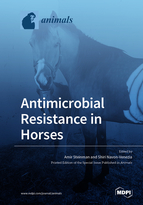Antimicrobial Resistance in Horses
A special issue of Animals (ISSN 2076-2615). This special issue belongs to the section "Equids".
Deadline for manuscript submissions: closed (31 January 2020) | Viewed by 24650
Special Issue Editors
Special Issues, Collections and Topics in MDPI journals
Special Issue Information
Dear Colleagues,
Antimicrobial resistance (AMR) is a global problem with extremely complex epidemiology involving the direct and indirect transmission of antibiotic resistant pathogens and mobile genetic elements between humans, animals and the environment, and is therefore being recognized as a One Health concern. Data describing AMR prevalence and trends is required in order to enable the judicious and prudent use of antimicrobials in animals, which has implications both from the veterinary and animal welfare aspects, as well as from a zoonotic and public health perspective.
Horses are one of the potential reservoirs of AMR that can be shared with humans, as was observed previously in several methicillin-resistant Staphylococcus aureus (MRSA) outbreaks in equine hospitals. Extended-spectrum beta-lactamases producing Enterobacteriaceae (ESBL-E), considered as the most clinically and economically important AMR burden in human and veterinary medicine, has been reported in both community and clinic equine populations. ESBL-E poses a major worldwide threat due to the geographical expansion of ESBL-producing clones, and the horizontal inter-species bacterial dissemination of ESBL-encoding plasmids and genes. In human medicine, ESBL-E infection is associated with increased morbidity, mortality, length of hospital stay, delay of targeted appropriate treatment and higher costs. These issues have not yet been demonstrated in horses.
We hereby invite authors to submit original high quality papers that provide a significant contribution to the understanding of AMR in horses. Topics of special interest are those describing the proper use of antibiotics for therapeutics and prophylaxis; the prevalence of multidrug resistant bacteria in different cohorts of horses and their effect on animal health and welfare; the emergence and dissemination of AMR patterns in various bacterial pathogens in different geographical areas and over time, as well as the associated risks.
Dr. Amir Steinman
Prof. Shiri Navon-Venezia
Guest Editors
Manuscript Submission Information
Manuscripts should be submitted online at www.mdpi.com by registering and logging in to this website. Once you are registered, click here to go to the submission form. Manuscripts can be submitted until the deadline. All submissions that pass pre-check are peer-reviewed. Accepted papers will be published continuously in the journal (as soon as accepted) and will be listed together on the special issue website. Research articles, review articles as well as short communications are invited. For planned papers, a title and short abstract (about 100 words) can be sent to the Editorial Office for announcement on this website.
Submitted manuscripts should not have been published previously, nor be under consideration for publication elsewhere (except conference proceedings papers). All manuscripts are thoroughly refereed through a single-blind peer-review process. A guide for authors and other relevant information for submission of manuscripts is available on the Instructions for Authors page. Animals is an international peer-reviewed open access semimonthly journal published by MDPI.
Please visit the Instructions for Authors page before submitting a manuscript. The Article Processing Charge (APC) for publication in this open access journal is 2400 CHF (Swiss Francs). Submitted papers should be well formatted and use good English. Authors may use MDPI's English editing service prior to publication or during author revisions.
Keywords
- horse
- equine
- antibiotic resistance
- one health
- multidrug resistance
- zoonosis
- risk factors
- colonization
- environmental shedding








